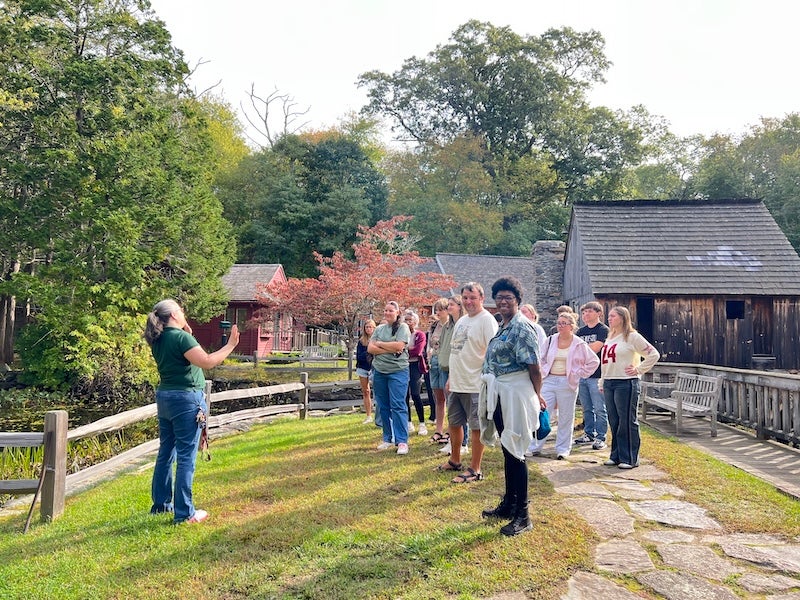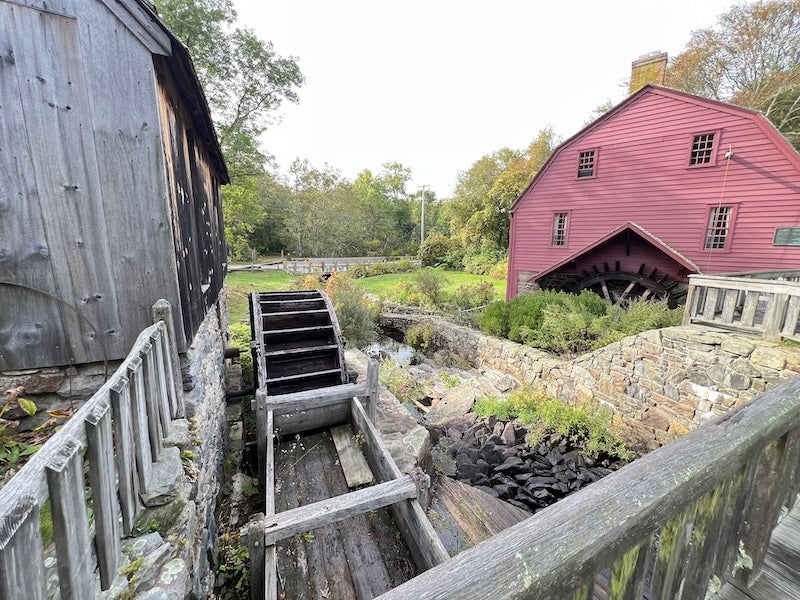Learning about Rhode Island’s industrial history–with a focus on historical water use, dam uses, fish ladders, and Gilbert Stuart’s connection to local grist mills–was on the day’s agenda for students in the Grand Challenge course Intro to Water Resources and Water Hydrology and Management recently. For almost a decade, the Gilbert Stuart Museum has been the class’s annual field trip destination, offering students a close-up of how water has been used and managed, from the 18th century to today. A site chosen for its comprehensive displays of water and resource management across three centuries, the Gilbert Stuart Museum tells not only the story of the man behind the famous Athenaeum portrait of George Washington, but also the story of one of the planet’s most precious resources: water.
“We selected the museum for a field trip because it offers a tangible, hands-on case study of water resource management across three centuries,” says Soni M. Pradhanang, Professor of Hydrology and Water Quality in the Department of Geosciences. She adds that the original 18th-century snuff mill gives students a look at some of the earliest forms of water being used to generate power, the mechanisms behind converting water into energy, and the ecological considerations with damming waters for hydropower. At the Gilbert Stuart Museum, Pradhanang shows students the “entire lifecycle of our relationship with a river: from historical tool to industrial engine, to a resource we are now learning to manage sustainably for both human and environmental needs.”
Gilbert Stuart was one of the country’s best-known portraitists. The Gilbert Stuart Museum, a restored and furnished 1750 home that was his birthplace, includes several icons of colonial New England: a collection of Stuart’s paintings, New England’s first snuff mill, and the fully-restored Hammond Gristmill. The property was also an industrial mill; it was the site of the first snuff mill in colonial New England. Snuff, which is made from finely ground tobacco leaves, was considered a popular luxury among the European and colonial genteel. The Hammond Gristmill ground corn into finely-ground cornmeal, using granite millstones and a large white oak waterwheel. To generate these mills, waterwheels were used to divert water from the ponds surrounding the property and helped power the heavy machinery that worked to grind tobacco and corn into snuff and grain, respectively.

Throughout the home, portraits of several individuals, including George Washington and several of the first American presidents, adorn its walls. Along the tour, students are given a rich and detailed history of Gilbert Stuart’s studies in painting, the evolution of his work over the years, and the story behind some of his most striking and well-known works. Viewing the site of Stuart’s birthplace and family residence, history and hydrology intersect, as Pradhanang explains of the connection between the famous portraitist and the site of his home. Pradhanang notes how the large wooden waterwheel used to generate the mill was what provided the family’s livelihood: “The income generated from this snuff mill supported the family and funded the early artistic training of a young Gilbert Stuart, who would go on to paint the famous ‘Athenaeum’ portrait of George Washington.”
Joining history, hydrology, and ecology all together in one location presents a unique opportunity for students to go beyond merely looking at textbook illustrations of water infrastructure, and instead witness its evolution through the years. The Gilbert Stuart Museum provides students with an immersive story into colonial New England history and demonstrates the evolution of hydrological machinery for powering mills. The experience also introduces real-life challenges and considerations of how human industrialization and local ecosystems are managed.
Article by Yvonne Wingard, CELS Communications Fellow.

